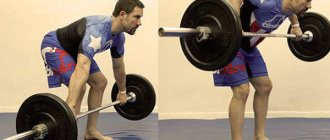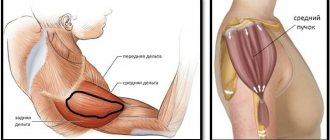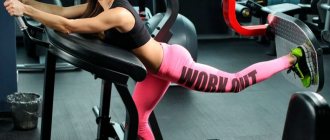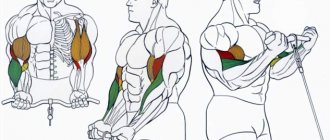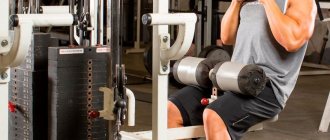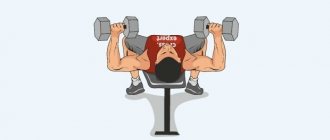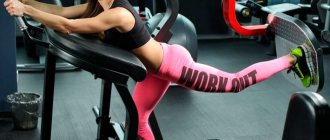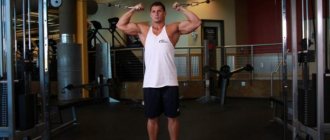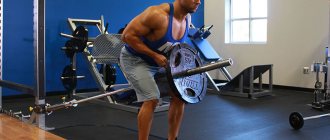Crossover traction on the rear delta: technique and variations
The crossover row for the rear deltoid is one of the most effective exercises that can effectively and deeply work the rear deltoid bundles. As an alternative, I will suggest abduction of arms in the upper blocks and similar exercises. If you use these two exercises in combination, you can achieve excellent relief and volume of the target muscles.
Exercise options
Let's consider several similar exercise options as an alternative.
Pull of the upper block to the face with a “rope” handle
- To perform this exercise, the athlete must take a position facing the block so that the cable is taut and the arms are straightened forward with the “rope” handle.
- The row is performed while exhaling by bending the arms at the elbow joints. The body is tilted back. The legs are positioned wider than the shoulders for better stability.
- The cable moves at forehead level. Hands (elbows) must be raised up and cannot be lowered below horizontal.
- At the peak of the movement, the elbows form an acute angle, the shoulder blades are brought together. A short pause is made and the reverse movement is performed as slowly as possible.
Pulldown of the upper block to the face with a “rope” handle in a sitting position
There is a version of this exercise in a sitting position. In my opinion, this option is better due to the fixation of the body and the constant angle of inclination. Technically, performing the exercise is no different.
Abduction of arms in the upper crossover blocks
- In order to perform this exercise, you need to take cables without handles crosswise, that is, in your left hand - a cable from a block located on the right, and in your right hand - a cable from a block located on the left.
- Leaning back and holding your arms above your head (for better stability, you should leave your leg back), abduct your arms to the sides.
- The arms, slightly bent at the elbow joints, are moved to the sides with fixation throughout the entire amplitude at the angle at which the shoulder girdle is located.
- The movement is performed while exhaling and at the peak of the amplitude there is a pause, after which, as slowly as possible, the arms return to their original position.
Bringing your arms to your chest while lying on an incline bench
Targeted object : clavicular head of the pectoral muscle.
How to do the exercise:
- set the bench at an incline of approximately 75°;
- place it centrally inside the simulator;
- adjust the cables so that when you grip the handles, your shoulders are at an angle of about 70° in relation to your torso;
- from a standing position, lie with your back on the bench;
- clasp the handles with your palms;
- Having slightly bent your elbows, begin to bring your arms across your body and slightly upward, so that when they meet, they are approximately at the level of your nose;
- hold in this position for 1-2 seconds, squeezing and straining your pectoral muscles;
- gradually relaxing the muscles, slowly return to the starting position.
Results . The exercise is a kind of hybrid of the lower row in the crossover and the pinch of the arms in the butterfly machine. However, because it creates a unique plane in which the movement occurs, it stimulates the muscles of the upper chest (just below the collarbone) well.
Implementation recommendations
- The exercise is performed at the end of the workout. The weight used is moderate.
- Number of repetitions: 12-14, 3-4 sets.
- When performing this exercise, like any other exercise on the back of the deltoid muscles, you must pay attention to the elbow joints. They should be located as high as possible. Under no circumstances should you lower your elbow joints, because then the latissimus and teres dorsi muscles will be involved.
The best combination using a crossover would be to perform lat pull-downs and abduct the arms in the upper crossover blocks. This combination is performed without a pause as a superset. To do this, the row must be performed with a weight of 50% of 1 RM, and the abduction must be performed with a weight of 30% of 1 RM. The first exercise (lat pulldown) is performed for 12 repetitions, and abduction is performed until failure.
Weight and number of repetitions
The number of repetitions and working weight depends on your goal and other parameters. But general recommendations can be presented in table form:
| Target | Approaches | Repetitions | Weight, %1Rm | Rest with one-on-one approaches |
| Strength development | 2-6 | 1-5 times | 100-85% | 3-7 min |
| Mass gain | 3-6 | 6-12 times | 85-60% | 1-4 min |
| Drying, relief | 2-4 | 13-25 times | 60-40% | 1-2 min |
You can make your training more varied and more effective if you change the number of repetitions and the weight of the projectile at each workout. It is important not to go beyond certain values!
*Indicate the weight of the apparatus and the maximum number of repetitions you can perform with this weight.
Don't want to count by hand? Install the AtletIQ app!
Electronic training diary Remembers your working weights Calculates the load for you Controls rest time
Pulldown from the upper block to the rear deltoid
Place in the ranking of authors: out of competition
(become an author) Date: 2018-01-31 Views: 136,640 Rating:
4.8
| more than 100 thousand views |
Why medals are given to articles:
| Bronze medal: | |
| 1. The article is in the TOP 100 2. The article has more than 3. The article has more than 100 | |
| Silver medal: | |
| 1. The article is in the TOP 50 2. The article has more than 3. The article has more than 500 | |
| Gold medal: | |
| 1. The article is in the TOP 10 2. The article has more than 1 3. The article has more than 1,000 | |
Description of the exercise
This exercise looks quite simple, but there are quite important and subtle nuances. If you master them, you can put a good load on your rear deltoids, isolating them to the maximum. Any upper block and ropes (such as for extension from the upper block) are suitable for this. Can be done both sitting and standing. Do what makes you feel the target muscle group better
1. It is important to twist your elbows to the sides and up. This will shift the load to the rear deltoid and reduce the load on the latissimus dorsi muscles.
2. You need to pull so as to pull the center of the ropes towards your forehead. That is, your hands should be high enough.
3. It is advisable to tilt your body back. This will create an angle at which the rear delt will work better.
4. This exercise should be done smoothly. Rocking and sudden movements will lead to the load being “spread” over a large number of muscles.
5. Try to start the movement from the elbow. Your task is not to pull the ropes as close as possible, but to move your elbows higher, to the sides and back. If you do everything correctly, the biceps and lats will hardly be involved in the work.
6. You should inhale when you release the ropes from yourself, and exhale at the end of the effort. That is, at the end of pulling yourself towards yourself.
Source
Crossovers: horizontal and sitting
A more powerful exercise in comparison with the classic exercise for the chest muscles in a crossover, but extremely rarely performed by athletes. Changing to a horizontal plane, bringing the arms together, works on the mass of the pectoral muscles. To perform the training, you need to install a horizontal or inclined bench in the center of the machine and lie down on it. Crossover training is reminiscent of dumbbell curls, but it is more effective because the load does not leave the pectoral muscles for a second.
Crossover training performed “sitting” is no less productive. In this position, the legs and back are not drawn into the work, and the crossover exercise acts with pinpoint precision on the pectoral muscles, and is not “smeared” over the body.
Rope handle pull to the face. What, why and why?
How to quickly discourage a newbie girl from the gym? It’s very simple - let her do men’s exercises: squats with a barbell, military press, etc. The next day it will be blown away by the wind. But this exact scenario of working with iron, in most cases, is offered by coaches to their newly minted wards. In other words, a masculine scheme is proposed for the construction of female forms. Of course, you can’t build tasty shapes on blocks alone, but it’s preferable to start with block-lever work. And we will analyze one of these options for working out the shoulders further in the text.
Note: For better assimilation of the material, all further narration will be divided into subchapters.
Muscle atlas
The exercise belongs to the isolated class and is aimed at working out the deltoids.
The muscle ensemble includes the following units:
- targeted – rear delta:
- synergists - infraspinatus, teres minor, anterior delta, trapezius (middle/bottom), rhomboid, brachialis, brachioradialis;
- dynamic stabilizers – biceps;
- stabilizers - back extensors.
A complete muscle atlas looks like this:
Advantages
By performing the rope handle to face exercise, you can expect to receive the following benefits:
- isolated training of the posterior delta;
- formation of a more spherical appearance of the shoulders;
- strengthening the shoulder joint;
- elimination of asymmetry in the development of deltas;
- injury prevention (including the ability to perform more pulling/pressing movements without risk).
Execution technique
The cable handle row to the face is an exercise of medium difficulty level. The step-by-step execution technique is as follows:
Step #0.
Go to the top block and set the required weight. Attach the rope handle and grasp it with both hands (palms facing each other). Move 1-2 steps away from the machine. Place your feet shoulder-width apart (or in a cross-legged position), tilt your body slightly back. Statically tighten your abs.
This is your starting position.
Step #1.
Inhale and as you exhale, pull the handle towards your face, moving your elbows back and to the sides. Fix at the end point of the trajectory and, while inhaling, return to the IP. Repeat the specified number of times.
In picture form, all this disgrace looks like this:
Variations
In addition to the standard version of the pulley rope pull, there are several variations of the exercise:
- from a lunge position;
- standing with elastic bands;
- sitting on the floor/bench.
Secrets and subtleties
To get the most out of the exercise, follow these guidelines:
- throughout the entire movement, monitor the position of your elbows - they should not fall below your shoulders;
- during traction, move the ends of the rope handle as far apart as possible;
- do not use inertia - lower the block slowly and under control and pull it explosively towards you;
- at the end point of the trajectory, hold for 1-2 counts and squeeze your shoulder blades;
- when returning the block to its place, do not let it fall all the way;
- do not look at your feet, look forward and upward;
- use different variations of the exercise and grip methods;
- breathing technique: inhale - when lowering the block down, exhale - when pulling upward/pull;
- numerical training parameters: number of approaches 3-5 , number of repetitions – 15-20 .
We're done with the theoretical side, now let's look at some practical points.
Is the cable row to the face an effective exercise for deltoids?
Research data (Journal strength & conditioning Res, USA 2015 ) on muscle EMG in rear deltoid exercises have shown that the best exercises are:
- traction to the face of elastic bands/rope handles, 78%;
- sitting bent over dumbbell raises, 75%.
Additionally, bodybuilding.com has a user rating of 8.4 , which is rated “Excellent.” This indicates the high practical significance of the exercise and its effectiveness.
Is it possible to pump up your shoulders using a block?
Not really. A block exercise machine is always either pre-fatigue or finishing/isolating a muscle group. This kind of work is most effective in women’s training, when a girl wants to “shape her shoulders.” For the male fraternity, this is ideal in the case of pumping – maximum pumping of blood/nutrients into a muscle group. Therefore, one of the delta training strategies involves first using 1-2 basic/conditionally basic movements and only then isolation work.
Actually, we’re done with the substantive part of the note, let’s move on to...
Afterword
+1 to the technical pantheon of AB notes - today it is the rope handle pull to the face. I am sure that until now you have never used this exercise. What if you try it and realize that this is it? Therefore, we blow into the hall and test the theory in practice. Good luck!
PS: do you use blocks in your training? What you are doing?
PPS: did the project help? Then leave a link to it in your social network status - plus 100 points to karma guaranteed
